| Slot: |
1850 1C J119
Perforation |
| Origin/Country: |
United States |
| Design Description: |
PATTERNS & TRIAL COINS 1792-1863 |
| Item Description: |
1C 1850 J-119 |
| Grade: |
PCGS PF 63 |
| Research: |
View Coin |
Owner Comments

1850 1C
J-119 Original, Pollock-134
Rarity: Low R.6 PR63
Struck in billon (10% silver, 90% copper) with a plain edge and medal turn.
The annular cent pattern, with a largish hole in the middle. It is interesting to note that Judd describes the obverse in the convention manner, as the side with the date, while Pollock reverse the sides.
Obverse: displays the denomination CENT at the top, the date 1850 is at the bottom, two rosettes are on each side, and a perforation in the center. It is interesting to note that Judd describes the obverse in the convention manner, as the side with the date, while Pollock reverse the sides.
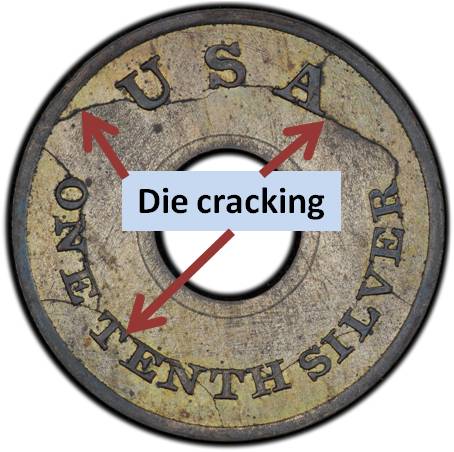 Reverse: USA inscribe at the top and "ONE TENTH SILVER" around at the bottom. It is curious the the U is not parallel to the rim on the inscription of USA. In the striking process of shattering and this piece shows the heavy die cracks that resulted. Reverse: USA inscribe at the top and "ONE TENTH SILVER" around at the bottom. It is curious the the U is not parallel to the rim on the inscription of USA. In the striking process of shattering and this piece shows the heavy die cracks that resulted.
Comment: Gray patina is seen over each side with bright, underlying silver-rose surfaces. A lovely example
With this pattern the Mint thought that a copper cent with a trace of silver, and in small diameter, could be produced to yield a profit. A problem with billon, was that the users of such coins had no way to notice the silver alloy, making them easy to counterfeit cheaply. Further, the making "holey" coins was a clumsy procedure.
Moreover, several years later on May 26, 1854, James Ross Snowden, then director of the Mint (since 1853), wrote to Secretary of the Treasury James Guthrie, noting that when eventually such billon pieces were redeemed after use, the cost of recovering the silver would exceed the value the silver metal obtained. Further: "The mechanical difficulties in making ring cents are not trivial. They lie not in planchet cutting but in stamping in ejecting the coin from the dies. I estimate that most of the value of a cent so formed would be sunk in the cost of striking."
Provenance/ Appearances:
Heritage Oct 2016 - Dallas / Lot #3963
|
| Slot: |
1850 1C J124
No Perforation |
| Origin/Country: |
United States |
| Design Description: |
PATTERNS & TRIAL COINS 1792-1863 |
| Item Description: |
1C 1850 J-124 |
| Grade: |
PCGS PF 64 |
| Research: |
View Coin |
Owner Comments
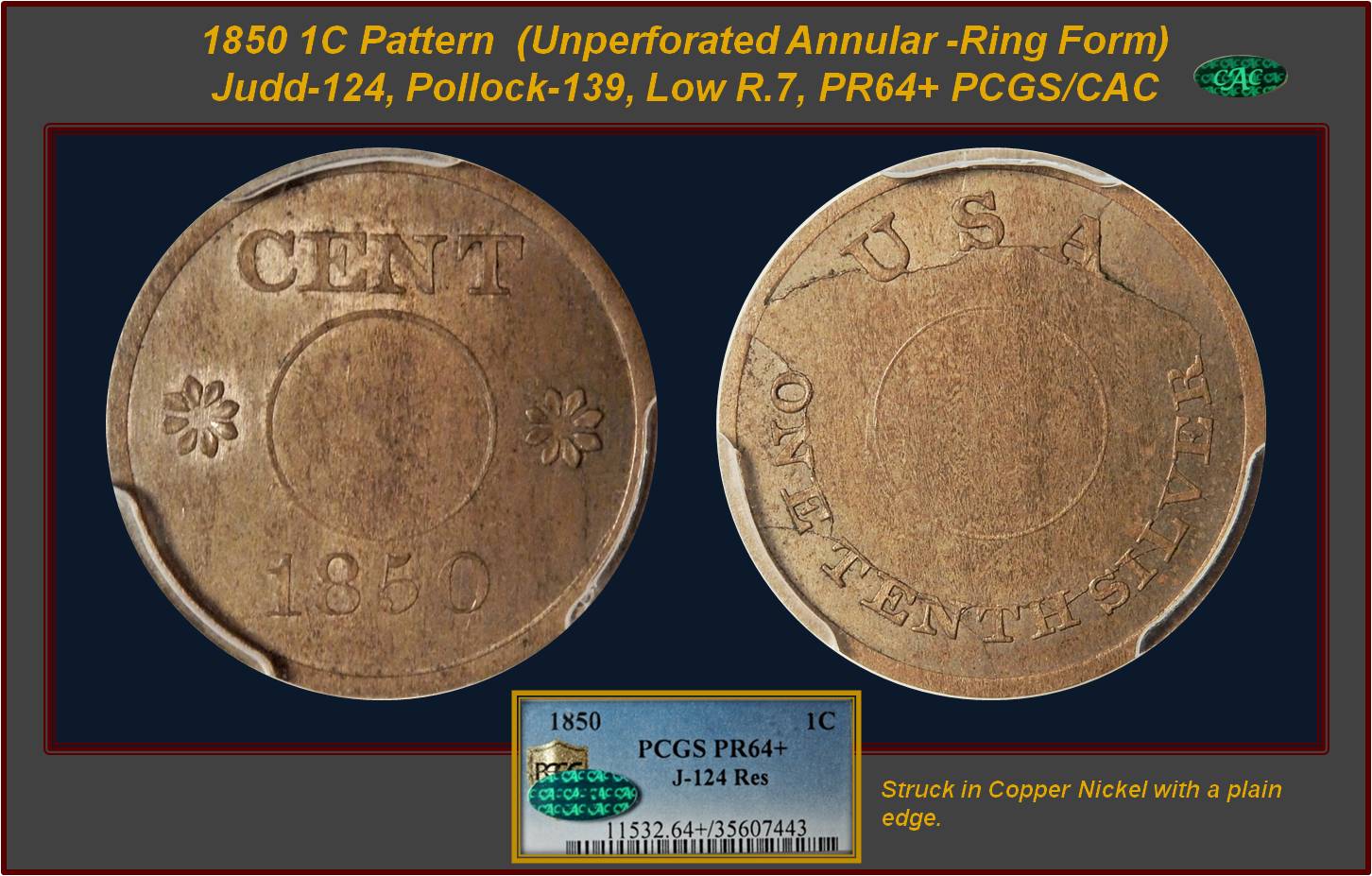
1850 P1C One Cent
Judd-124 Restrike, Pollock-139 --- same as the J-119 but without the perforation.
Rarity: Low R.7, PR64 + CAC Endorsed
Ex: Lumus
Struck in copper-nickel with a plain edge
Obverse: : CENT above place for undrilled hole, 1850 is beneath, floret are to either side of the unpunched hole.
Reverse: “USA” arcs above space for undrilled hole, and “ONE TENTH SILVER” curves below. Extensive die breaks on the reverse.
Comment: An experiment in producing a smaller-size cent piece, one intended, of course, to be produced in silver with a central perforation to lower the weight and corresponding silver content. The originals were produced in billon (90% copper, 10% silver), with weights from 24 to 26 grains, but they were too subject to counterfeiting, among other difficulties with the issue.
indicate the
The piece is is a Light gray-rose color covering both sides, with some minor flecks noted on both sides but nonetheless attractive. The reverse (ONE TENTH SILVER) side shows extensive peripheral die breaking through the legends. The die apparently shattered early during the striking of the original restrike status of this piece, of which only a half dozen or so are known.
Provenance/Appearance:
Private sale June 2019; Prior
|
| Slot: |
(1851) 1C J127
Dateless & Perforation |
| Origin/Country: |
United States |
| Design Description: |
PATTERNS & TRIAL COINS 1792-1863 |
| Item Description: |
1C (1851) J-127 |
| Grade: |
PCGS MS 64 |
| Research: |
View Coin |
Owner Comments
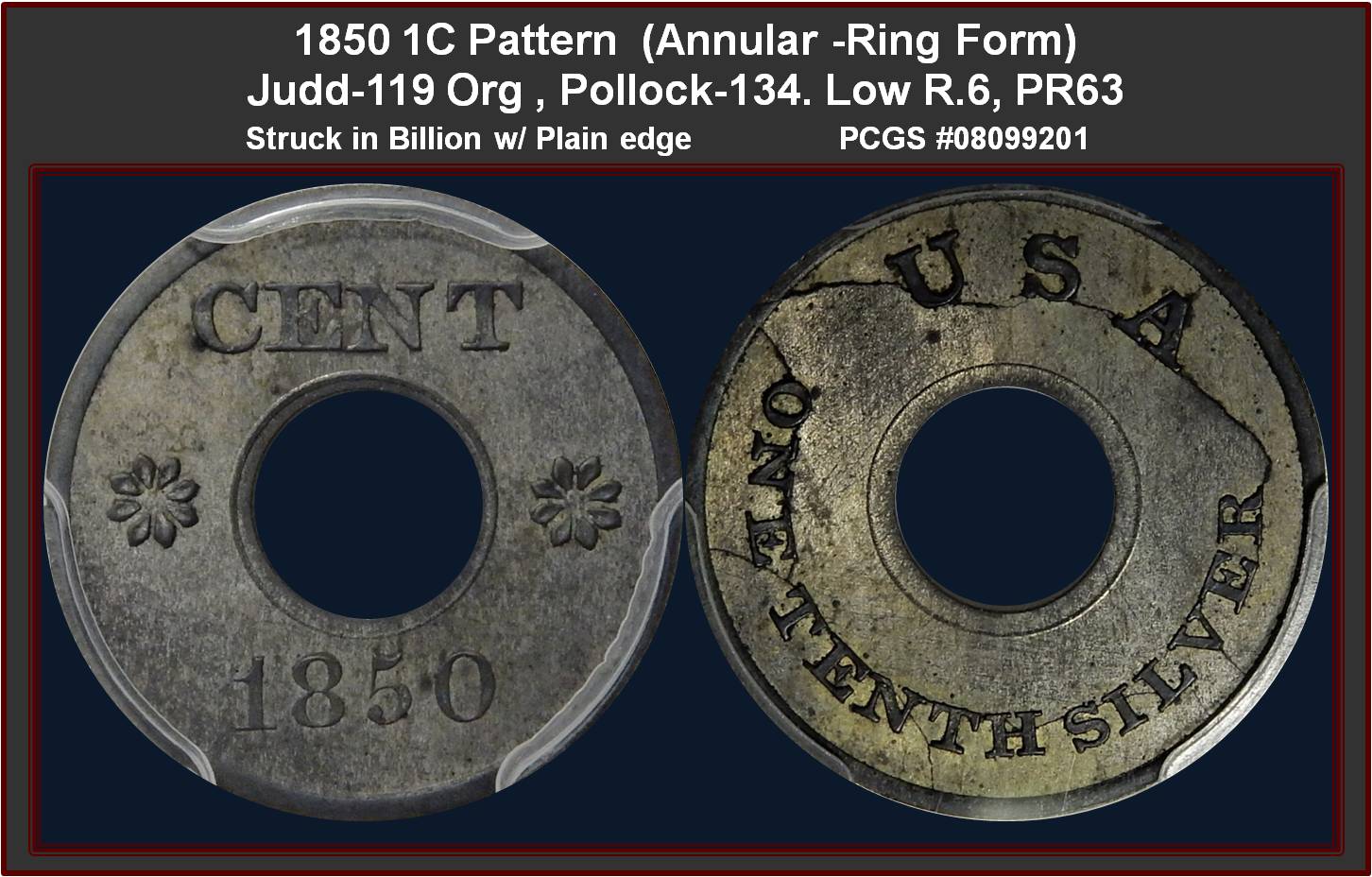
(1851) ONE TENTH
Judd-127 Original, Pollock-149,
Rarity: Low R.6; MS64
Struck in billon (10% silver, 90% copper) with a plain edge.
Obverse: Features CENT at the top and ONE TENTH SILVER at the bottom, Struck in 1851 these pieces are dateless
Reverse: Reverse depicts a laurel wreath and the legend UNITED STATES OF AMERICA.
Comment
Part of an effort to reduce the diameter of the cumbersome large cent but these were most likely struck just to test the materials as perforations was abandon in the prior year. This piece is center perforated, unlike restrikes.
The surfaces are hazy gray and there is a planchet lamination across much of the obverse. Sharply defined and otherwise well struck. Billion must be difficult to classify as Proof but no articles indicated a "Business Strike" for the J-127 even though PCGS has slabbed a couple J-127's as MS vs a proof designation
Provenance/ Appearances:
Heritage Aug 2017 ANA Auction - Denver / Lot #5393
|
| Slot: |
1853 1C J151
Quarter Eagle obverse |
| Origin/Country: |
United States |
| Design Description: |
PATTERNS & TRIAL COINS 1792-1863 |
| Item Description: |
1C 1853 J-151 |
| Grade: |
PCGS PF 62 |
| Research: |
View Coin |
Owner Comments

1853 E1C One Cent
Judd-151, Pollock-178
Rarity: Low R.6, PR62 CAC Endorsed
Struck in Copper Nickel ( believed 40% Nickel / 60% copper) with Reeded Edge
Obverse: Liberty Head with 13 stars - same as regular issue 1853 Quarter Eagle
Reverse: The denomination of "One Cent" within a laurel wreath.
Comment:
This pattern issue combines the obverse of 1853 quarter eagles with a new reverse inscribed ONE CENT. Composition was copper-nickel alloy similar to the “German silver” alloy used by Lewis Feuchtwanger for his private cent patterns of 1837. This alloy combined copper, nickel, and zinc in various proportions.
Three such compositions were recorded:
40% copper, 40% nickel, 20% zinc;
30% nickel, 60% copper, 10% zinc; and
40% nickel, 60% copper.
Although each composition had its own inherent coloration, practical considerations suggest these cannot easily be distinguished by color alone. Specific gravity of these compositions do not provide the necessary distinction.
This piece is a lovely Pewter gray, with light striated toning visible on both sides. Some underlying reflectivity in the fields. A scratch is noted along Liberty's throat, but is not likely to be noticed without magnification.
Provenance/Appearances:
Purchased from Park Avenue Mar 2015; From the 1853 Collection. Stacks and Bowers Oct 2014 Winter Baltimore Sale/ Lot #1058, Prior Purchased privately from South Miami Rare Coins, Feb 1991.
|
| Slot: |
1854 1C J159a
Experimental Cent |
| Origin/Country: |
United States |
| Design Description: |
PATTERNS & TRIAL COINS 1792-1863 |
| Item Description: |
1C 1854 J-159a |
| Grade: |
PCGS PF 64 Brown |
| Research: |
View Coin |
Owner Comments
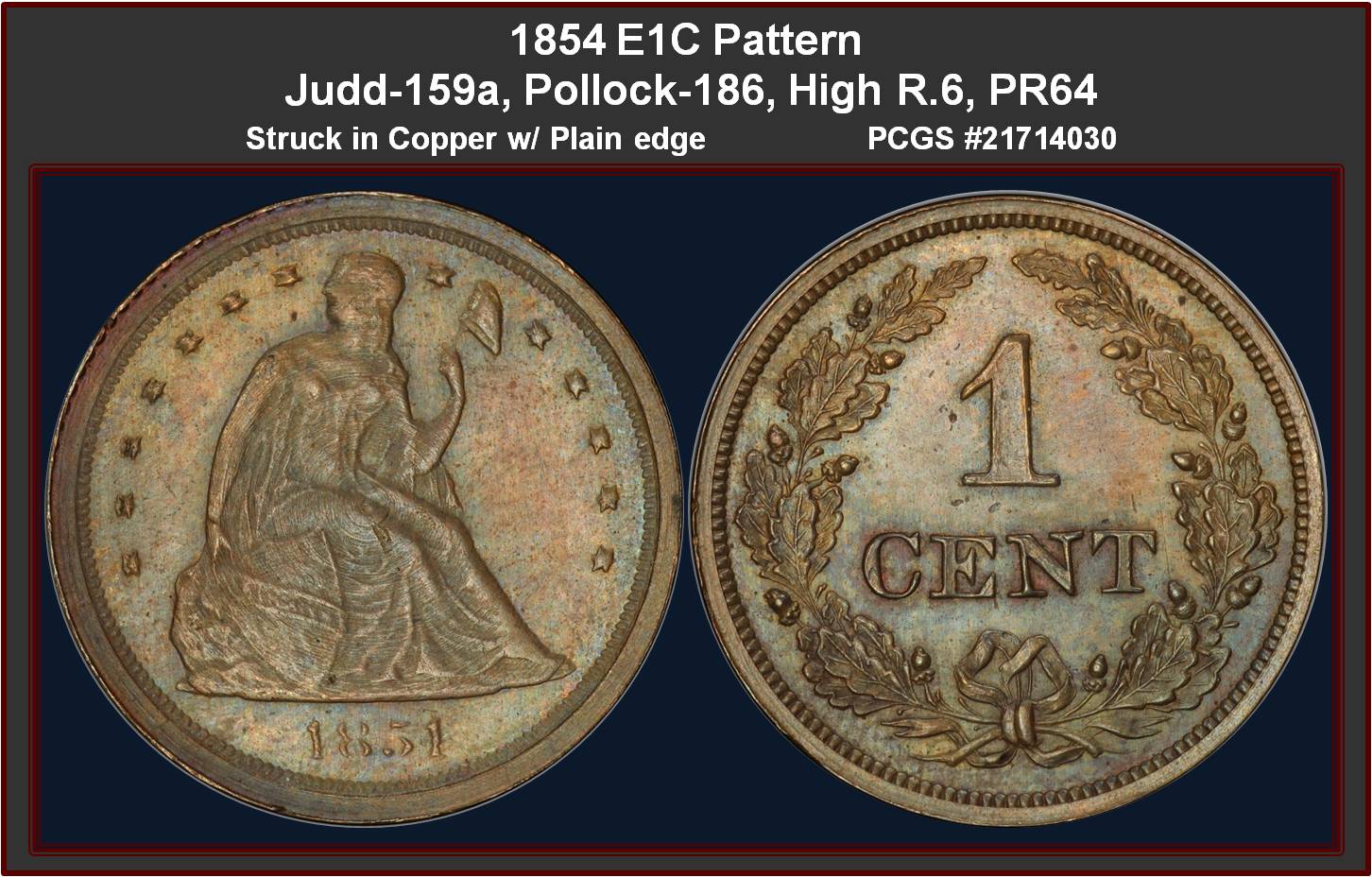
1854 1C
Judd-159a, Pollock-186,
Rarity: High R.6, PF64
Struck in copper with a plain edge.
Obverse: Gobrecht's Liberty Seated motif, as seen on the circulating silver issues of the era, 13 thin, attenuated stars around Liberty, date below.
Reverse: 1 CENT within open-topped wreath of oak leaves and acorns, bow at bottom of wreath.
Comment: An unusual pattern variety. The obverse die was made by crudely reducing an 1854 silver dollar with a lathe, causing prominent concentric die lines and blurry design details. The date resembles 1851. The reverse shows 1 CENT encircled by an oak and acorn wreath. The while the die struck Judd-159 is a formidable rarity (two or three known) but its electrotype copper counterpart Judd-159a is somewhat more available but not by much with only 13 - 20 pieces believed to exist. 
The original holder the edge was obscured by the encapsulation, which made it impossible to confirm the seam that distinguishes Judd-159a from Judd-159 was there. After having it re-holder PCGS confirmed it was a Judd-159. It was not until the 8th Edition of Judd reference book that the 2 different varieties were separated. Both sides exhibit a wire rim, especially steep on the obverse near 11 o'clock.
A sea-green and tan-brown near-Gem with a few tiny flan flaws on the central reverse.
Provenance/Appearances:
From The Tom & Jean Fore Collection. Heritage Jan 2016 - Tampa / Lot #6272;
Prior
- Dallas Signature (Heritage, 12/2004), lot 6346;
- Heritage Jan 29, 2005 Continuous Internet Auction / Lot #23425;
- Sherman's Obsessive Compulsive Collection, Stacks June 2010 Baltimore / Lot 3396;
- Stacks August 2011 Chicago ANA / Lot 9003;
|
| Slot: |
1854 1C J160
Starless Braided Hair |
| Origin/Country: |
United States |
| Design Description: |
PATTERNS & TRIAL COINS 1792-1863 |
| Item Description: |
1C 1854 J-160 |
| Grade: |
PCGS PF 64 Brown |
| Research: |
View Coin |
Owner Comments

1854 1C
Judd-160, Pollock-187
Rarity: R.4; PF64BN
From the Lux Family Collection, begun as early as the 1850s.
Struck in Copper with Plain Edge
Obverse: : The usual head of Liberty facing left from the contemporary large cent design, with the date below. No other design elements are present, so the effect is a pleasing cameo. The diameter is slightly smaller than the contemporary regular issue large cent.
Reverse: : An exact copy of the current large cent, however the design elements are not only smaller for the reduced size of the coin, but the size of the lettering and wreath are also smaller, producing a more elegant ensemble. Thus the wreath is compact and the letters are more finely executed.
Comment: : This is an attractive Choice specimen that exhibits dominant medium brown patina with glints of original faded orange luster persisting, more so on the reverse than the obverse. Sharply struck overall and pleasingly smooth.
Provenance/Appearances: :
Stacks and Bowers March 2021 Auction - Session 5 / Lot 5596; From the Lux Family Collection, that began as early as the 1850s.
|
| Slot: |
1854 1C J161
Starless Braided Hair |
| Origin/Country: |
United States |
| Design Description: |
PATTERNS & TRIAL COINS 1792-1863 Large 1 C |
| Item Description: |
1C 1854 J-161 |
| Grade: |
PCGS PF 63 Brown |
| Research: |
View Coin |
Owner Comments

1854 1C
Judd-161, Pollock-187
Rarity: R.4 Original; PF63BN
Struck in Bronze with Plain Edge
Obverse: : The usual head of Liberty facing left from the contemporary large cent design, with the date below. No other design elements are present, so the effect is a pleasing cameo. The diameter is slightly smaller than the contemporary regular issue large cent.
Reverse: An exact copy of the current large cent, however the design elements are not only smaller for the reduced size of the coin, but the size of the lettering and wreath are also smaller, producing a more elegant ensemble. Thus the wreath is compact and the letters are more finely executed.
Comments:
Lovely struck large Cent with nice bright brown surfaces.
This design the same as the J-160 above - Pollock did not assign a unique reference number between these Judd samples as he believed you can not distinguish without a metallurgic testing.
Provenance/Appearances: :
From ANA Money Show 2005 Atlanta, Prior Heritage Aug 2004 - Pittsburgh, PA Signature Sale / Lot #7880
|
| Slot: |
1854 1C J164
Large Flying Eagle |
| Origin/Country: |
United States |
| Design Description: |
PATTERNS & TRIAL COINS 1792-1863 |
| Item Description: |
1C 1854 J-164 |
| Grade: |
PCGS PF 65 Brown |
| Research: |
View Coin |
Owner Comments

1854 1C Flying Eagle
Judd-164 Original, Pollock-189
Rarity: R.5, PR65 BN
Struck in bronze with a plain edge.
Obverse: Flying Eagle design with a hook-neck eagle on the obverse, surrounded by stars and the date below.
Reverse: Closely resembles the regular dies issue for the large cent. A continuous wreath with ribbon at bottom. 2 leaves at under the E (of States). 2 other rarer reveres varieties exists with different # of Leaves
Comments:
US patterns.com states that Originals are said to be from 90 to 100 grains with re-strikes weighing about 113 grains.
A pleasing wood grain effect is noted on the obverse, while uniform chocolate-brown color prevails on the reverse.
Provenance/Appearance:
Private sale with Ric Snow; Prior Heritage Spt 2016 Long Beach Signature Auction / Lot #5866; Heritage Feb 2002 Long Beach Signature Auction/ Lot #7270
|
| Slot: |
1854 1C J168
Large Flying Eagle |
| Origin/Country: |
United States |
| Design Description: |
PATTERNS & TRIAL COINS 1792-1863 |
| Item Description: |
1C 1855 J-168 |
| Grade: |
NGC PF 61 BN |
| Research: |
View Coin |
Owner Comments
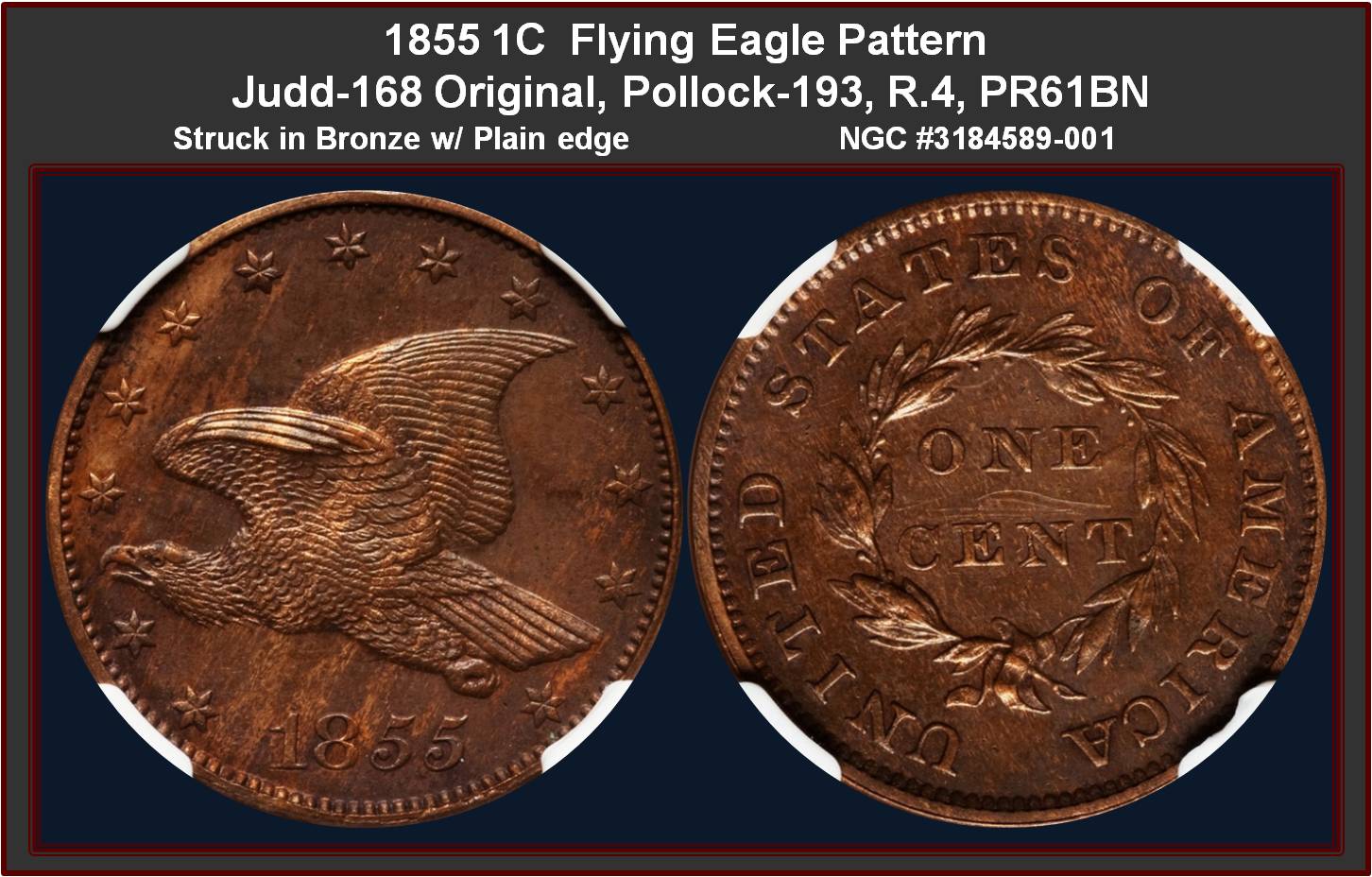
1855 1C Large Cent Flying Eagle
Judd-168, Pollock-193
Rarity: R.4; PF61BN
Struck in bronze with a plain edge.
Obverse: The large cent version of the flying eagle was designed with 13 stars surround an eagle.
Reverse: Similar to the 1855 large cent. The diameter is smaller than the large cents but larger than the small flying eagles that were officially adopted in 1857.
Comment:
This coin is similar to the Christian Gobrecht/Titian Peale flying eagle design for the Gobrecht dollars (and soon the Flying Eagle cents).
The planchet shows streaks ( actually attractive), as often seen on this pattern. A few pin scratches are seen between ONE and CENT on the reverse.
Provenance/Appearances:
Heritage Oct 2011 Signature Auction- Pittsburgh / Lot #4543
|
| Slot: |
1855 1C J170a |
| Origin/Country: |
United States |
| Design Description: |
PATTERNS & TRIAL COINS 1792-1863 |
| Item Description: |
1C 1855 J-170a |
| Grade: |
PCGS PF 64 |
| Research: |
View Coin |
Owner Comments
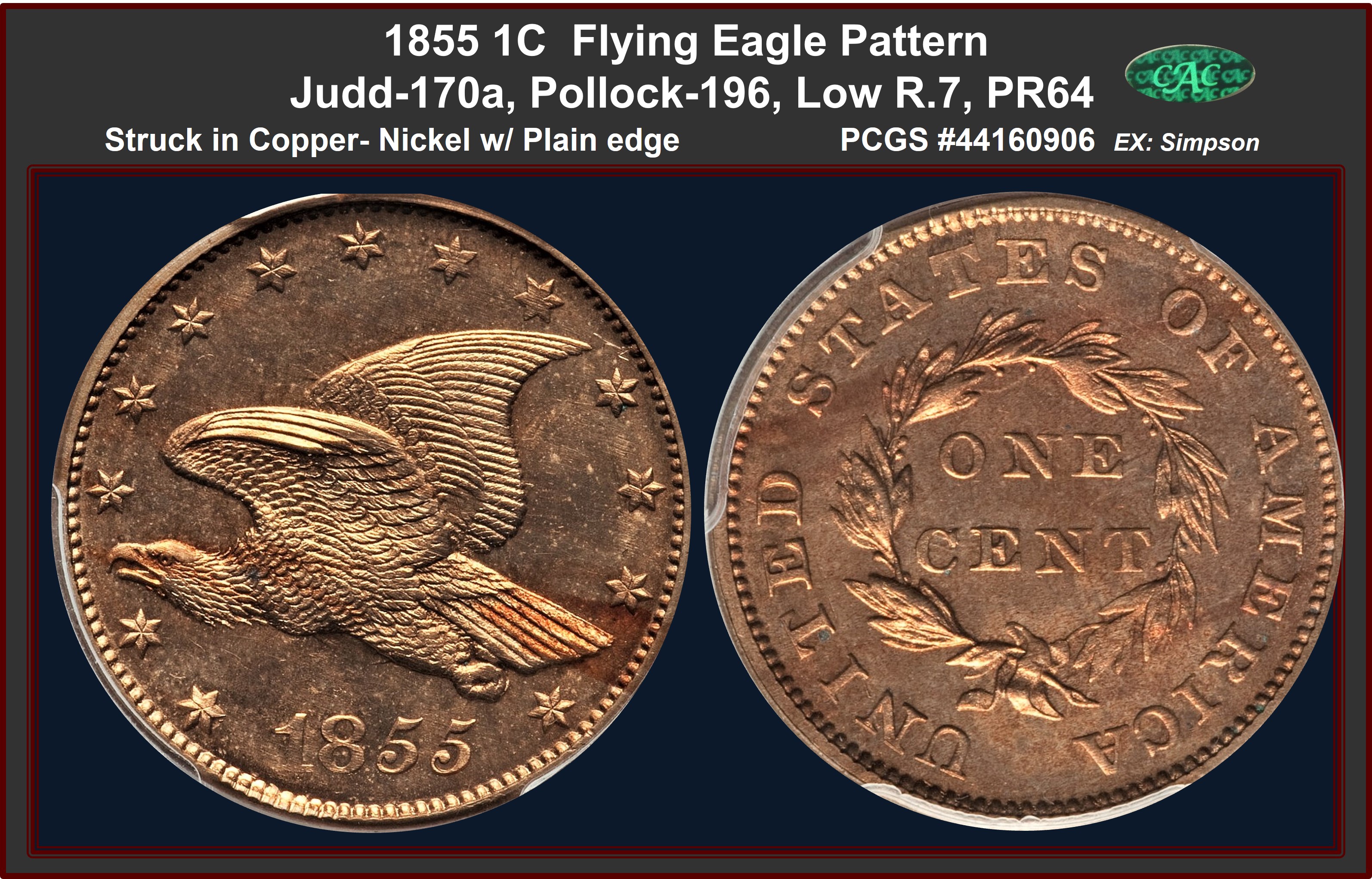
1855 1C Flying Eagle Cent,
Judd-170a, Pollock-196
Rarity: Low R.7, PR64 CAC Endorsed
Ex: Simpson.
Struck in copper-nickel with a plain edge.
Obverse: Thirteen stars surround an eagle that is flying slightly upward, similar to the Christian Gobrecht/Titian Peale flying eagle design for the Gobrecht dollars (and soon the Flying Eagle cents). ‘
Reverse: The reverse design is similar to the issued large cent.
Comment:
 The diameter is intermediate between the large cents struck for commerce in 1855 and the small cents that were first produced in 1856 These still represent a still-to-be-discovered metallurgical variants. The major variants include copper/bronze, oroide, various compositions of copper-nickel, German silver, and pure nickel. The diameter is intermediate between the large cents struck for commerce in 1855 and the small cents that were first produced in 1856 These still represent a still-to-be-discovered metallurgical variants. The major variants include copper/bronze, oroide, various compositions of copper-nickel, German silver, and pure nickel.
The surfaces of this piece display the expected bright yellow-tan appearance of the nickel alloy with occasional streaks of red on each side.
Is is believed to be Copper-nickel 90% copper and 10% nickel
This piece was also the Plate coin image included in the article by Rick King in the April 23, 2023 The Numismatist
magazine on the subject of the mints experimentation with different metal compositions.
Provenance/ Appearances:
Ex Simpson, Heritage May 2022 CSNS / Lot #3633
|
| Slot: |
1856 1C J180
Flying eagle |
| Origin/Country: |
United States |
| Design Description: |
CENTS - FLYING EAGLE, PROOF |
| Item Description: |
1C 1856 EAGLE |
| Grade: |
PCGS PF 63 |
| Research: |
View Coin |
Owner Comments

Judd-180, Pollock P-212
Rarity: R.2 PR63 CAC Endorsed
Struck in copper Nickel with plain Edge
Obverse: A eagle in flight to the left with UNITED STATES OF AMERICA above and the date below.
Reverse: The denomination "ONE CENT" within an agricultural wreath of corn, wheat,cotton and tobacco leaves.
In Pollock this is the reverse type "B" diagnostic by "E" in CENT is open and "E" in ONE is closed combined with the tip of of the leaf is above the base of the "C" and the tip of the leaf near the "T" is well below the base of the "T"
 Comment: Comment:
Richard Snow outlines nicely the 1856 history in “A guide Book of Flying Eagle and Indian Head Cents”. It appeared the 1st batch of patterns were struck in Mint State and freely exchange hands within the government with hundreds of samples and most likely many made their way into circulation. After the 1857 Eagle production started and release collectors became interested in finding 1856 pieces. The mint director ordered additional Proof formats minted in 1858 . The Snow -9 Center Dot is the diagnostic for these “RESTRIKE” proof versions
|
| Slot: |
1856 1C J184
Flying eagle |
| Origin/Country: |
United States |
| Design Description: |
PATTERNS & TRIAL COINS 1792-1863 |
| Item Description: |
1C 1856 J-184 |
| Grade: |
PCGS PF 62 |
| Research: |
View Coin |
Owner Comments

1856 1C Flying Eagle
Judd-184 Pollock-220, Snow-PT1,
Rarity: Low R.7. PF62
Ex: Simpson
Struck in copper-nickel with a plain edge.
Obverse: Was struck from the normal 1856 Flying Eagle cent dies, showing a flying eagle in a plain field with the legend UNITED STATES OF AMERICA and the date below. The O in OF is squared-off.
Reverse: Exhibits an oak wreath with ornamental shield above and the denomination ONE CENT in the center -- a design vaguely presaging the regular-issue reverse with shield and oak wreath of the 1860-1909 Indian cents.
Comment:
The dies correspond to Rick Snow's Die Pair 2, without a line below the amulets on the left side of the shield. Snow writes that probably not more than 25 Judd-184 representatives were struck at some point between 1856 and 1858. This PR62 example is tan-gold with violet, steel, and peach-orange accents. A couple of stray marks appear over the date.
Provenance/Appearances:
From Bob Simpson Collection Part 3, Heritage Jan 2021 Signature Auction / Lot #3074
|